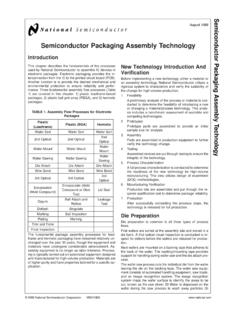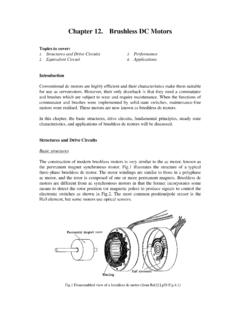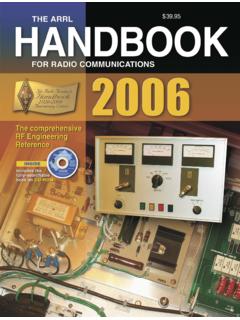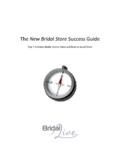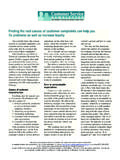Transcription of HOW TO MAKE SPRINGS - Educypedia
1 How to make SpringsPage 1 of 62 HOW TO make SPRINGSI ntroduction2 spring Design3 Materials6 Wire Safety8 Equipment11 Tooling14 The Setup20 Torsion28 Extension34 Compression40 Finishing47 Other Types of Springs50 spring Shops58 Glossary60 The HTML version of this document ( ~ ) waswritten and illustrated by Dave Silberstein, who holds and retains the full to make SpringsPage 2 of 62 HOW TO make SPRINGST here are three things you'll need to read before you get started. First, theDISCLAIMER: This document is designed to provide information in regard to the subject matter beingcovered.
2 Every effort has been made to ensure the accuracy of its contents. However theremay be mistakes, both typographical and in content. Additionally, work in the metal tradesimplies an acceptance of the risk of injury, loss, or damage, the cause of which is clearlybeyond the control of the writer of a work on the subject. Therefore, the author of thisdocument accepts no responsibility or liability whatsoever for any injury, loss or damagesustained by a reader who, having read this material, then seeks to apply what he or she haslearned therein. Please read the Terms of Use at ~ , before you start to work with spring wire, read the section on safety.
3 When youhave read that section, read it again. No kidding. And third, about this document: I've tried to write for the benefit of someone who has(or can gain access to) basic hand and power tools. The sections of the document arearranged in logical order presuming a minimal knowledge of the metalworking trades ingeneral or of springmaking in particular, and cross-linked to provide a forward path thatleads from this point through the entire manufacturing process. There's a glossary ofspring terminology, which should help you to define terms and find additional possible, I've indicated where to find additional information in the main body ofthe comments or suggestions for improvement should be made to INTRODUCTIONThis section will give you some basic information about SPRINGS , what they look like,what their parts are, and how they work.
4 If you already know about SPRINGS and want to get right to it, be my guest. There are three basic types of SPRINGS : Compression SPRINGS can be found in ballpoint pens, pogo sticks, and the valveassemblies of gasoline engines. When you put a load on the spring , making itshorter, it pushes back against the load and tries to get back to its original SPRINGS are found in garage door assemblies, vise-grip pliers, andcarburetors. They are attached at both ends, and when the things they are attachedto move apart, the spring tries to bring them together SPRINGS can be found on clipboards, underneath swing-down tailgates,and, again, in car engines.
5 The ends of torsion SPRINGS are attached to other things,and when those things rotate around the center of the spring , the spring tries topush them back to their original the Glossary for detailed diagrams of these types of to make SpringsPage 3 of 62 spring DESIGNIf you're trying to make a spring to replace a broken one, you don't need to know awhole lot about design. On the other hand, if you're making a prototype of a machine,for instance, and you don't know exactly what you want, then this book is for you. Hereyou'll learn some basic data about spring design, which is what you'll need to know tomake exactly the spring you PrinciplesThere are three basic principles in spring design: The heavier the wire, the stronger the spring .
6 The smaller the coil, the stronger the spring . The more active coils, the less load you will have to apply in order to get it tomove a certain on these general principles, you now know what to do to change the propertiesof a spring you already have. For instance, if you want to make automotive valvesprings a little stronger than stock, you can a) go to a slightly heavier wire and keep thedimensions and coil count the same, b) decrease the diameter of the spring , keepingthe wire size and coil count the same, or c) decrease the number of active coils,keeping the wire size and spring diameter the same.
7 Naturally, you can also go to astronger material to achieve the same result. Now, what if you're making a spring from scratch, with nothing to go on in the way of asample? You can engineer your own design (see the next chapter for the math), coil aspring, and then test it. If it's what you want, fine. If it's, let's say, a skosh too strong,then you can a) go to a lighter wire, b) open up the coil diameter, or c) increase thenumber of active coils to get a slightly weaker spring . Or, if you want to make things really simple, go ~ ,where you'll find a few websites that offer online design!
8 How to make SpringsPage 4 of 62 MathematicsNaturally, spring design software is available -- you can find out where to get it ~ For the purists (or those who don'twant to pay for a program), here's a very short summary of the mathematics of springdesign. These equations, by the way, are taken from The New American Machinist'sHandbook, published by McGraw-Hill Book Company, 1955. I don't pretend tounderstand them. There's a lot more in the way of engineering that goes into spring design: these are onlythe basic equations. If you're interested, you can contact someone who makes springdesign software or (gasp!)
9 Find it in the library under Dewey classification You can also contact the spring Manufacturers' Institute they makea handy-dandy spring calculator, suitable for simple design work, that anyone can learnto use. They also have spring design software, training classes, and a bunch more sez, "Check it out."Design LimitationsDepending on what kind of spring you want to design, and depending on where it will beused, your design will be limited: For all SPRINGS : A spring under load is stressed. If you put too much stress on a spring , its shapewill deform and it will not return to its original dimensions.
10 The material from which the spring is made will have an effect on the strength ofthe spring : it will also have an effect on how much stress the spring willwithstand. The section on spring materials will tell you more about this. When you heat spring wire (which you always do), it may change its , the section on materials will tell you more about this. How to make SpringsPage 5 of 62 For compression SPRINGS : If the spring will set solid (compress all the way, so that all the coils touch eachother) at the limit of its travel, the diameter of the wire times the number of coilscannot be greater than the space allowed, unless you want the spring itself to actas a mechanical stop to the motion.



